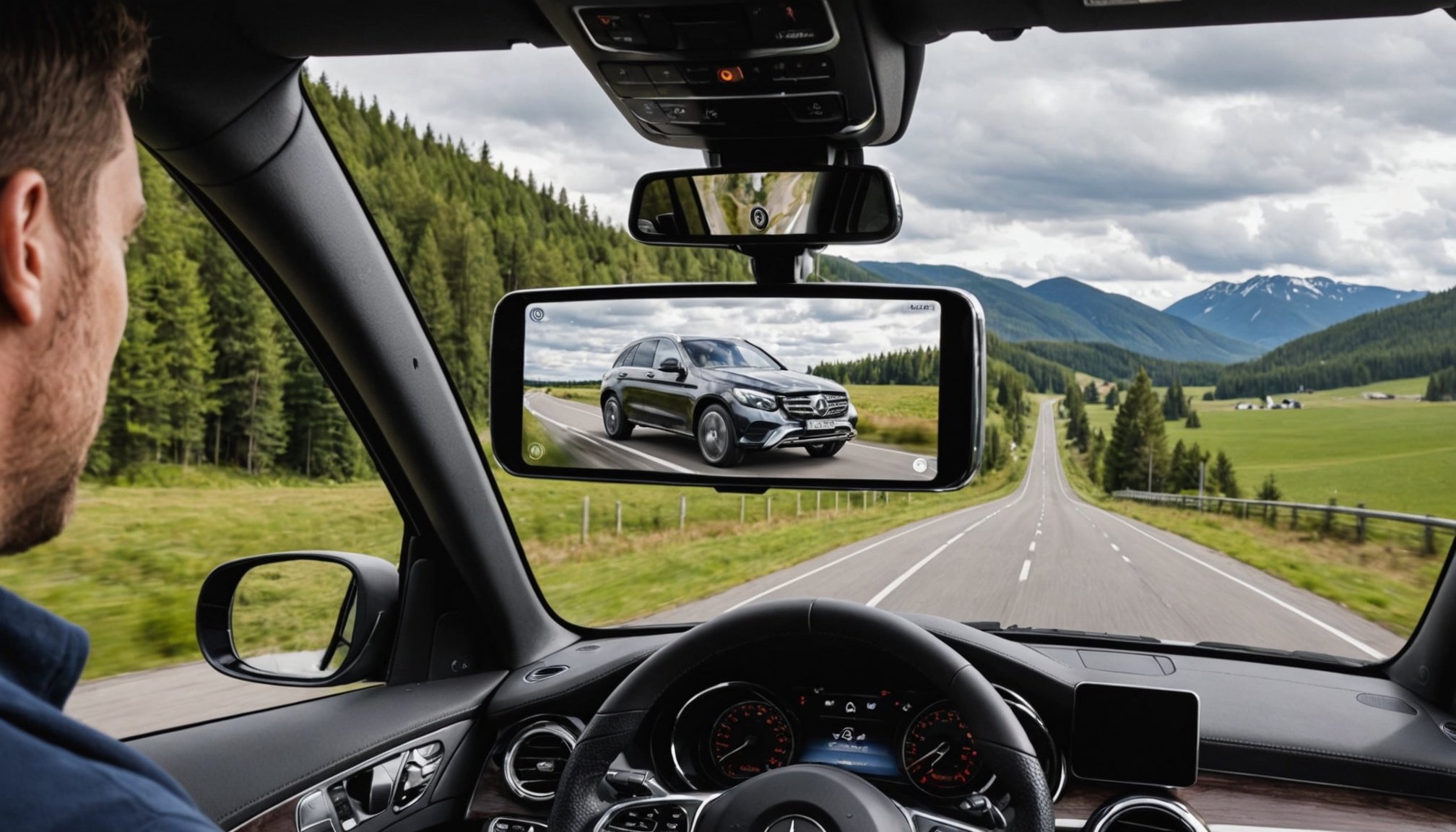Transform Your Mercedes-Benz GLC: The Ultimate Guide to Installing a High-Tech Digital Rearview Mirror for Enhanced Visibility
Why Upgrade to a Digital Rearview Mirror?
When it comes to enhancing the driving experience of your Mercedes-Benz GLC, one of the most significant upgrades you can make is installing a high-tech digital rearview mirror. This innovative feature not only improves visibility but also adds a touch of modern technology to your vehicle.
“A digital rearview mirror is more than just a luxury; it’s a safety feature that can significantly reduce blind spots and enhance your overall driving experience,” says John Smith, a seasoned automotive technician.
Additional reading : Ultimate guide to coilover installation and fine-tuning for your bmw m3: step-by-step instructions for maximum performance
Here are some key reasons why you should consider this upgrade:
- Enhanced Visibility: Traditional rearview mirrors can be limited by the rear seats, headrests, and even passengers. A digital rearview mirror uses a high-resolution camera mounted at the rear of the vehicle to provide a clear, unobstructed view.
- Reduced Blind Spots: With a digital rearview mirror, you can see more of what’s behind you, reducing the risk of accidents caused by blind spots.
- Improved Night Vision: Many digital rearview mirrors come with night vision capabilities, making it easier to drive in low-light conditions.
Preparing for the Installation
Before you start the installation process, it’s crucial to prepare your vehicle and gather all the necessary tools and components.
Tools and Components Needed
- Digital rearview mirror kit
- Screwdrivers (flathead and Phillips)
- Wire strippers
- Electrical tape
- Mounting brackets
- Power drill (if necessary)
Here’s a step-by-step guide to ensure you’re ready:
- Park Your Vehicle Safely: Ensure your Mercedes-Benz GLC is turned off and parked on a level surface. This will prevent any accidental movements during the installation.
- Gather All Tools and Components: Make sure you have everything you need before starting the installation. This includes the digital rearview mirror kit, tools, and any additional hardware required.
- Consult Your Manual: Refer to your vehicle’s manual or the installation guide provided with the digital rearview mirror kit to understand the specific requirements for your model.
Step-by-Step Installation Guide
Installing a digital rearview mirror is a relatively straightforward process, but it does require some technical know-how. Here’s a detailed guide to help you through it:
Removing the Existing Rearview Mirror
- Start by removing the existing rearview mirror. This usually involves unscrewing a few screws and gently pulling the mirror away from the windshield.
- Disconnect any electrical connections to the old mirror.
Installing the Camera
- Locate the best position for the rear camera, typically at the rear of the vehicle, such as on the license plate frame or near the rear window.
- Mount the camera securely using the provided brackets and screws.
- Ensure the camera is aligned properly to provide a clear view.
Connecting the Camera to the Digital Rearview Mirror
- Run the camera cable from the rear of the vehicle to the interior, usually through the trunk and under the floor mats.
- Connect the camera cable to the digital rearview mirror. This may involve splicing wires or using connectors provided in the kit.
- Secure any loose wires with electrical tape to prevent damage.
Mounting the Digital Rearview Mirror
- Mount the digital rearview mirror to the windshield using the provided mounting brackets. Ensure it is securely fastened and adjusted to your preferred viewing angle.
- Connect the power cable to the vehicle’s electrical system, following the manufacturer’s instructions.
Features and Benefits of a Digital Rearview Mirror
A digital rearview mirror offers a plethora of features that enhance both safety and convenience.
Key Features
- High-Resolution Display: Provides a clear and detailed view of what’s behind your vehicle.
- Night Vision: Enhances visibility in low-light conditions.
- Adjustable Brightness: Allows you to adjust the screen brightness to your comfort.
- Wide-Angle View: Offers a broader view compared to traditional rearview mirrors.
Here’s a comparison table highlighting the key differences between traditional and digital rearview mirrors:
| Feature | Traditional Rearview Mirror | Digital Rearview Mirror |
|---|---|---|
| Visibility | Limited by rear seats and headrests | Unobstructed view from rear camera |
| Night Vision | No night vision capabilities | Enhanced visibility in low-light conditions |
| Adjustable Brightness | No adjustable brightness | Adjustable screen brightness |
| Wide-Angle View | Narrow view | Broader view from rear camera |
| Blind Spot Reduction | Higher risk of blind spots | Reduced blind spots |
Practical Insights and Actionable Advice
When installing a digital rearview mirror, there are several practical insights and tips to keep in mind:
Tips for Installation
- Consult Professionals: If you are not comfortable with the installation process, consider consulting a professional mechanic or auto electrician.
- Test the System: Before finalizing the installation, test the digital rearview mirror to ensure it is working correctly and providing a clear view.
- Adjust for Comfort: Adjust the digital rearview mirror to a comfortable viewing angle to avoid straining your neck or eyes while driving.
Maintenance and Troubleshooting
- Regular Cleaning: Regularly clean the rear camera lens to ensure clear visibility.
- Software Updates: Check for software updates for the digital rearview mirror to ensure you have the latest features and improvements.
- Troubleshooting: If you encounter any issues, refer to the user manual or contact the manufacturer’s support for assistance.
Integrating with Other Advanced Features
A digital rearview mirror can be part of a broader suite of advanced safety and convenience features available in the Mercedes-Benz GLC.
Lane Keeping Assist
- The GLC class often comes with lane keeping assist, which works in tandem with the digital rearview mirror to enhance driving safety.
Parking Camera
- Many models of the GLC include an exterior parking camera, which can be integrated with the digital rearview mirror for a comprehensive view during parking.
Blind Spot Assist
- Blind spot assist is another feature that complements the digital rearview mirror by alerting you to vehicles in your blind spots.
Here’s what a satisfied owner has to say about these features:
“The combination of the digital rearview mirror, lane keeping assist, and blind spot assist has made driving my Mercedes-Benz GLC so much safer and more comfortable. It’s like having an extra pair of eyes on the road,” says Emily Johnson, a proud owner of a 2025 Mercedes-Benz GLC 300.
Upgrading to a digital rearview mirror is a significant step in enhancing the safety, visibility, and overall driving experience of your Mercedes-Benz GLC. With the right tools, a bit of technical know-how, and some practical advice, you can transform your vehicle into a more modern and secure driving machine.
Whether you’re driving through busy city streets or navigating through tight parking spaces, a digital rearview mirror is an investment that will pay off in the long run. So why wait? Transform your Mercedes-Benz GLC today and experience the future of driving.











